When I chose the location as a possible one for growing roses, I knew that the challenges were many. Roses are thirsty plants; but they do not like wet feet. Roses like damp roots but they cannot stand damp air. And there was the question about whether they could possibly retain soil so well as the native grasses that were already growing there. After all, after two inches of rain you could hear the water rushing through the gulch from 200 feet away. It could probably sweep away a small car. It was with some trepidation that I proceded.
Among the first roses to be planted in the gulch were Graham Thomas, Day Breaker, Liebeszauber, Sunsprite, Mardi Gras, and South Africa in one very sunny location just in front of the chain link fence. That would have been around the year 2012. These roses literally took off. So it seemed a promising plan. Next year two Mme Plantier roses were planted in other locations. At the same time, four Prosperity roses and three Red Eden roses were spaced out in regular intervals along the fence. The challenge for these roses was that they were in the shade of an alligator juniper tree. So shade was a potential problem. The Prosperity roses have never minded the shade. It's hard to tell about the Red Eden roses. They have not yet reached six feet tall, which seems a little short to me for a climbing rose in its sixth season. By comparison, Gruss an Zabern in a much drier and shadier location, planted as a band two years later is two feet taller.
Still, the success with Prosperity prompted me to continue planting, and the place is home to a fairly large collection of roses, mostly David Austin roses. Over the eastern half of the planting one would find William Shakespeare 2000, Princess Anne, Young Lycidas, LD Braithwaite, and Lady of Shallott hovering around the well established Prosperity and Conrad Heinrich Soth. Over the western half one would find Susan Williams - Ellis, Darcy Bussell, Lady of Shallott, Ascot, Colorific, Jubilee Celebration, and Colorific all in a jumble near Prosperity and Ghislaine de Feligonde. Somewhere in the middle of the jumble is Erinnerung an Brod. No rose in the gulch looks better out of bloom, and none grows better; but after three years we are still waiting for its best performance. It took five years for Ghislaine de Feligonde to hit its stride, so there is still hope. Near the east end of the planting are two rugosa roses Moje Hammarberg, and near the west end of the planting are two rugosa alba roses. These were selected for flower fragrance and edible hips. Also because there is a lot of sand in the soil and rugosas are said to do well on sand. Near the center of the planting is a Boscobel, and an Auguste Renoir. Queen of Sweden. Moore's Striped Rugsa, and Mary Rose died. White Out has struggled. Awakening, a sport of New Dawn, has moped a bit since being transplanted two years ago. Rosy Cushion grows and blooms almost as vigorously as Darlow's Enigma.
What makes this place unique? Below is a shot of the western end of the gulch planting in which one might be able to find Boscobel, Prosperity, Darcy Bussel, Ascot, Colorific, Jubilee Celebration, and Lady of Shallott. And, of course a lot of eight inch river rock laid over landscape fabric. There are some daylilies and two Louisiana iris in the photo, all in their first season in the garden. To the left one can just make out the chain link fence that encloses the garden, marking where the rose bed ends and the arroyo grasses start. The fence is on the south edge of the bed. On the north edge of the bed is an elevated path built atop a 20 inch wall of 85 lb concrete landscape blocks. We did this to keep the roaring stream from eroding the raised beds to the north and to keep the flagstone walk from sinking into the muddy stream.
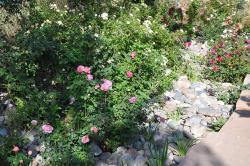
This area is a gulch or arroyo. In the Northeastern United States and in Northern Europe there is no term for this geographical phenomenon; it does not exist. Here in the mountain west of the US, though, it's common enough. It's a place where water runs for part of the year. Over other parts of the year it can be bone dry. As arroyos go, this one is somewhat modest in its moisture swings. It receives underground seeps for much of the dry season, Feb-May. And it drains quite quickly during the rainy season; there is very little standing water. In May the relative humidity of the air can be 12%. When we have a really good monsoon season as we did this year, the gulch runs with water continuously for maybe four weeks, and the relative humidity can approach 100% for several weeks at a time. The air in this spot passes through freezing maybe as often as 100 times in a calendar year, though it is possible for the soil in this location not to freeze or to freeze only two or three inches deep in the depths of winter in late January. In the brightest moments of the year - most of the month of June - the UV index is 10. A person with fair skin can get a painful burn in less than 15 minutes.
Madame Plantier at the western extreme of the garden, about two weeks prior to peak bloom, with Hollywood Nights at her feet. The grasses native to the arroyo, shown in the background, are quite tenacious
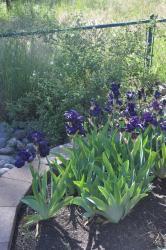
So the potential problems for roses in this location include: wet feet, drought, dry air, high humidity, bright sun, excess shade, and late killing frosts, and competition from grasses that are very well adapted to the location. I have paid some attention to how suitable a rose is for shade in my plantings. I have also tried to plant blackspot resistant varieties - although my level of success here is far from perfect. Ghislaine de Feligonde, for instance, bears most of the brunt of the alligator juniper's shade. It is almost directly north of the tree. At high summer it is far enough away that it gets only the lightest shade near noon. At other hours the sun is high enough in the sky that it gets sun. Near either equinox, though, it may not get four hours of sun. Also near the tree are two of the four Prosperity and one Erinnerung an Brod. G de F bloomed for a full six weeks straight this year. Prosperity is showing just a touch of mildew this August, but none of these cultivars has been touched by blackspot.
Ghislaine de Feligonde
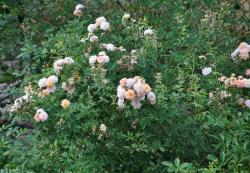
Prosperity, William Shakespeare 2000, and Conrad Heinrich Soth
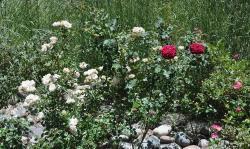
I have been worried about losing soil and about controlling weeds, so a year ago I had sixteen tons of 6-8 inch river rock installed over landscape fabric in this area. This has had a profound effect on erosion and on weeds. I find that I can almost control the weeds over the entire area by informally pulling up the occasional bit of grass or nutsedge as I walk through the area taking photgraphs. Acknowledging the arroyo for what it is has improved its performance as a rose bed and it has maintained its function as a repository for good soil.
But what about wet feet and fungal disease?
I have certainly lost roses to these factors. Queen of Sweden and Mary Rose, are among the roses that have died. But they died over the winter. Or during a dry season, or before getting established. Peter Frankenfield lost all its leaves during a spring flood, then regained them; but it has not looked good since. I've lost track of which rose appears below, but I suspect it is Jolie Veranda. It is planted in one of the lower spots in the gulch and its roots would have been submerged for most of six weeks starting in the beginning of July.
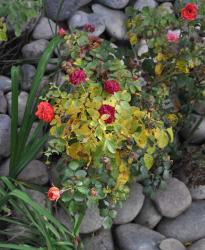
One can, of course, see a little blackspot moving in, but this is an opportunistic infestation: the rose leaves had already yellowed by the time the BS hit. One of three Darcy Bussell has experienced similar yellowing. These are the only two roses in the planting that are at serious risk of dying as a direct result of having their roots submerged for six weeks this summer. By now the water is receding. There is no running or standing water in the arroyo right now and there has not been for a week. So there is some chance that both of these roses will survive.
Fungal disease in the garden has been interesting this year. I moved two roses that were hit hard by it last year. And I have been using Actinovate, though not so carefully as I should have been. These factors seem to have made for a later onset; but where it hit this year it hit quickly. In the gulch, Colorific was the first rose to suffer. Not long afterwords, neighboring Teasing Georgia was hit. At about the same time at the other end of the garden, the older leaves of Sunsprite suffered from it. Then the old leaves of South Africa did. Next, it was newer foliage on Liebeszauber and Day Breaker. The whole process took maybe two weeks.
Colorific, with water flowing over its roots and leaves starting to get black spot.
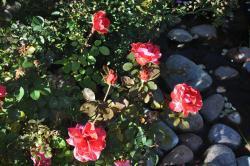
A week after this photo was taken, virtually every leaf on Colorific shows infection. Old leaves on many roses throughout the garden show signs of disease. I have never before seen blackpsot on Hermosa, for example; but all the old leaves on this plant are covered with it. New growth leaves, fortunately, remain untouched. The distinction is essential because a rose that can retain its new growth leaves despite infection can continue to function. A rose that loses its new growth leaves quickly to the infection has ceased thriving and has started on a downward slope toward death. It will suffer until it can sustain new growth leaves for some weeks without BS infection.
It is a matter of some frustration to me that just two or three weeks after the conditions for Colorific and Liebeszauber became satisfactory for them to grow vigorously they contracted black spot on new growth leaves. No other roses in the garden this year have been quite so perverse. In the case of Colorific, I think the plant is vigorous enough to overcome the problem. I'm a little less certain of Liebeszauber. This is the first year I have noticed BS on Liebeszauber; but this is also the first year in about five that it has attempted making new canes. I am disappointed with South Africa and Day Breaker; but I know the disease started on neighboring Sunsprite. I wonder whether the three instances of this rose will have to be moved this winter. The more I consider it, the better the idea seems to me.
The jury is out about what will happen next. The rains have let up a bit. The air is a little cooler and drier. From here on out we expect new blackspot infestation to be slower than it was two weeks ago. But we also near the end of the useful new foliage period. Foliage that forms after mid September here does not always provide so much nutrition to the plant as the energy used to form it, especially if we get early frosts in October.
Blackspot has been a problem, but it has hit a smallish number of roses fairly late in the season. And only two roses have any measurable amount of BS on foliage formed after the start of August. So it seems unlikely that the disease will endanger the lives of any of the roses in the garden this year. Overall, it has been a pretty successful experiment. Let's look at some of the successes.
Ascot blooms with Jubilee Celebration

Pomponella Fairy Tale rose grows on a slightly elevated bank of the gulch
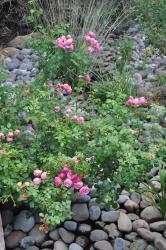
Double Red Knockout in its first season photographed near the start of the deluge. Its leaves have yellowed a bit since
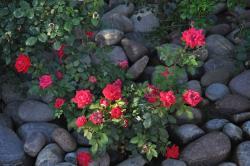
Darcy Bussell in late June. At its best the flowers are drop-dead gorgeous in their deep wine red color. Though quite generous in bloom, it can be a little uneven.

The once-blooming James Mason is very well adapted to this environment, growing vigorously and never complaining about shade, drought, high humidity, frost, or pretty much anything.
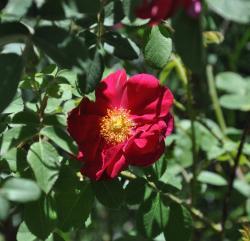
Peter Frankenfield (presumed to be) in July before the monsoons started
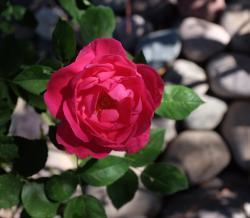
Colorific in mid June before the monsoons started.
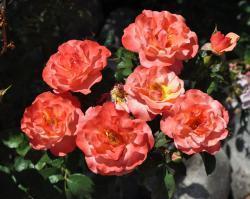
Teasing Georgia in mid June before the monsoons started.
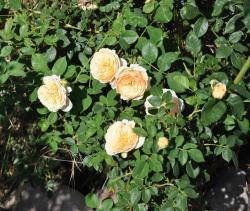
Graham Thomas blooming in front of the chain link fence with some Day Breaker roses in front.
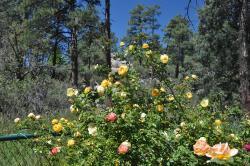
One Graham Thomas blossom
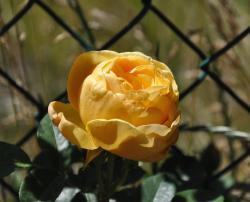
South Africa blooming through the black spot
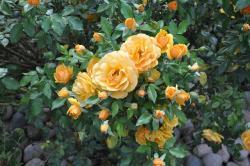
After about five years of experience of growing roses in this particular arroyo, what do we know? Prosperity and Ghislaine de Feligonde are well suited to the gulch. Conrad Heinrich Soth is so vigorous that the question is more about whether I will dig it up to keep it from overrunning the garden than it is about whether it could survive there. Pomponella Fairy Tale and Rosy Cushion are definitely happy. I'm pretty sure that Jubilee Celebration and Lady of Shallott are keepers in this location. Most of the other David Austin roses, I think, are keepers; although I feel a little embarrassed to have lost track of the identies of most. I cannot, with any certainty, distinguish among Wm Shakespeare 2000, LD Braithewaite, and Young Lycidas. The rugosas seem to be doing well, though they are not yet very foliferous. I have no reservations about Graham Thomas. I'm pretty sure I will do what it takes to keep Day Breaker and South Africa alive in this location, even if it means removing Sunsprite. Colorific has put on such a show this year in its second season that I intend to tend it carefully over the next growing seasons to keep it from being too seriously damaged by blackspot. Experience with Cressida and Winchester Cathedral suggest to me that some DA roses can be quite materially affected by blackspot while still thriving; so I am quite hopeful about Teasing Georgia. It is still in better shape than Golden Celebration was at this point last year. It has taken Golden Celebration most of this season to recover; but TG strikes me as a more vigorous rose.
I am ready to declare the experiment a success. I cannot say with any certainty which roses will be growing in the gulch ten or fifty years from now; but I am very pleased with what I see there now. I pass many pleasant hours in the garden and the experience just would not be the same were the gulch not chock full of roses.
Post a new thread about this blog entry: